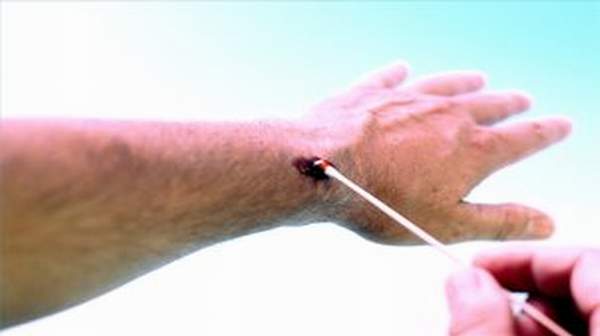
What's in this article?
A puncture wound is caused by an object piercing the skin and creating a small hole. Some punctures are just on the surface. Others can be very deep, depending on the source and cause.
A puncture wound does not usually result in excessive bleeding. Usually, these wounds close fairly quickly without any intervention. Treatment may be necessary to prevent infection in some wounds. A puncture wound from a cause such as stepping on a nail can become infected because the object that caused the wound may carry bacteria or spores Clostridium spp that cause tetanus into the skin and tissue.
The subject of puncture wounds discussed here is meant to cover only the non-lifethreatening wounds, and is not an article that covers deep organ penetrating wounds seen with guns, large knives, lances or other similar objects.
A puncture wound doesn’t usually cause excessive bleeding. Often the wound seems to close almost instantly. But this doesn’t mean treatment isn’t necessary. A puncture wound such as from stepping on a nail can be dangerous because of the risk of infection.
To take care of a puncture wound:
- Wash your hands. This helps avoid infection.
- Stop the bleeding. Apply gentle pressure with a bandage or clean cloth.
- Clean the wound. Rinse the wound with clear water. If dirt or debris remains in the wound after washing, use tweezers cleaned with alcohol to remove the particles. If debris still remains, see a doctor. Clean the area around the wound with soap and a washcloth.
- Apply an antibiotic. Apply a thin layer of an antibiotic cream or ointment (Neosporin, Polysporin). Certain ingredients in some ointments can cause a mild rash in some people. If a rash appears, stop using the ointment.
- Cover the wound. Bandages can help keep the wound clean and keep harmful bacteria out.
- Change the dressing. Do this at least once a day or whenever the bandage becomes wet or dirty.
- Watch for signs of infection. See a doctor if the wound isn’t healing or you notice any redness, increasing pain, drainage, warmth or swelling.
Puncture Wound Causes
Common causes of puncture wounds are wood splinters, pins, nails, and glass. Puncture wounds may also be caused by objects such as scissors and knives. Almost any sharp object can potentially cause a puncture wound.
Symptoms of Puncture Wounds
Symptoms include:
- Bleeding
- Problems with function or feeling below the wound site
- Pain
Infection may occur with some cuts and puncture wounds. The following are more likely to become infected:
- Bites
- Punctures
- Crushing injuries
- Dirty wounds
- Wounds on the feet
- Wounds that are not promptly treated
Preventing Puncture Wounds
Prevent Puncture wounds by taking the following steps to ensure your physical safety:
- Play in debris-free areas.
- Do not play sports without using proper protective gear.
- Wear shoes and make sure the soles are sturdy and cannot be punctured by a nail.
- Do not use heavy machinery or tools without wearing proper safety equipment and shoes.
- After an accident, quickly clear away debris such as broken glass.
- Dry up spills (especially on slippery surfaces) before running or walking over the surface.
Treatment for Puncture Wounds
A puncture wound must be cleaned properly and monitored throughout the healing process to avoid complications.
Even if you have gone to an emergency room for immediate treatment of your puncture wound, see a foot and ankle surgeon for a thorough cleaning and careful follow-up. The sooner you do this, the better: within 24 hours after injury, if possible.
The surgeon will make sure the wound is properly cleaned and no foreign body remains. He or she may numb the area, thoroughly clean inside and outside the wound, and monitor your progress. In some cases, x-rays may be ordered to determine whether something remains in the wound or if bone damage has occurred. Antibiotics may be prescribed if necessary.
Avoiding Complications for Puncture Wounds
Follow the foot and ankle surgeon’s instructions for care of the wound to prevent complications.
Infection is a common complication of puncture wounds that can lead to serious consequences. Sometimes a minor skin infection evolves into a bone or joint infection, so you should be aware of signs to look for. A minor skin infection may develop in two to five days after injury. The signs of a minor infection that show up around the wound include soreness, redness, and possibly drainage, swelling, and warmth. You may also develop a fever. If these signs have not improved, or if they reappear in 10 to 14 days, a serious infection in the joint or bone may have developed.







